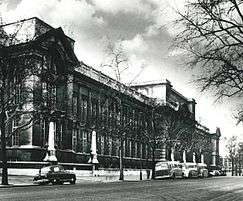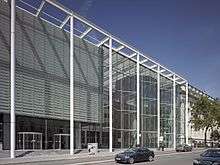Imperial College London
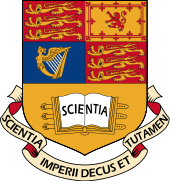 | |||||||||||||||||||||||
| Motto | Scientia imperii decus et tutamen[1] | ||||||||||||||||||||||
|---|---|---|---|---|---|---|---|---|---|---|---|---|---|---|---|---|---|---|---|---|---|---|---|
Motto in English | Knowledge is the adornment and protection of the Empire | ||||||||||||||||||||||
| Type | Public research university | ||||||||||||||||||||||
| Established | 1907 by Royal Charter[2] | ||||||||||||||||||||||
| Endowment | £126.2 million (as of 31 July 2016)[3] | ||||||||||||||||||||||
| Budget | £946.8 million (2015-16)[3] | ||||||||||||||||||||||
| President | Alice Gast | ||||||||||||||||||||||
| Provost | James Stirling | ||||||||||||||||||||||
| Visitor | The Lord President of the Council ex officio | ||||||||||||||||||||||
Academic staff | 3,692[4] (as of 2014) | ||||||||||||||||||||||
Administrative staff | 7,240[4] (as of 2014) | ||||||||||||||||||||||
| Students | 17,035 (2015/16)[5] | ||||||||||||||||||||||
| Undergraduates | 9,240 (2015/16)[5] | ||||||||||||||||||||||
| Postgraduates | 7,795 (2015/16)[5] | ||||||||||||||||||||||
| Location | London, United Kingdom | ||||||||||||||||||||||
| Colours |
| ||||||||||||||||||||||
| Affiliations | |||||||||||||||||||||||
| Website |
www | ||||||||||||||||||||||
 | |||||||||||||||||||||||
Imperial College London is a public research university located in London, United Kingdom. Its founder, Prince Albert, envisioned an area composed of the Victoria and Albert Museum, Natural History Museum, Royal Albert Hall, and the Imperial Institute.[6][7] His wife, Queen Victoria, laid the foundation stone for the Imperial Institute in 1888.[8] Imperial College London was granted Royal Charter in 1907. In the same year, the college joined the University of London, before leaving it a century later.[9] Through merging with several historic medical schools, the curriculum expanded to include medicine. In 2004, Queen Elizabeth II opened the Imperial College Business School.[8]
The main campus is located in South Kensington. Imperial is organised into faculties of science, engineering, medicine, and business. The university's emphasis is on emerging technology and its practical application.
Imperial is consistently cited among the top universities in the world. In 2017, it ranked 8th in the Times Higher Education World University Rankings, 8th in the QS World University Rankings, and 22nd in the Academic Ranking of World Universities.[10] In 2015, Imperial was ranked the most innovative university in Europe.[11] Staff and alumni include 15 Nobel laureates, 2 Fields Medalists, 70 Fellows of the Royal Society, 82 Fellows of the Royal Academy of Engineering, and 78 Fellows of the Academy of Medical Sciences.[12]
History
The Great Exhibition
The Great Exhibition in 1851 was organised by Prince Albert, Henry Cole, Francis Fuller and other members of the Royal Society for the Encouragement of Arts, Manufactures and Commerce. The Great Exhibition made a surplus of £186,000 used in creating an area in the South of Kensington encouraging culture and education for everyone. Its founder, Prince Albert, envisioned a cultural area composed of the Victoria and Albert Museum, Natural History Museum, Royal Albert Hall, and the Imperial Institute.[13][14] His vision built the Victoria and Albert Museum, Science Museum, Natural History Museum, Geological Museum, Royal College of Science, Royal College of Art, Royal School of Mines, Royal College of Music, Royal College of Organists, Royal School of Needlework, Royal Geographical Society, Institute of Recorded Sound, Royal Horticultural Gardens, Royal Albert Hall and the Imperial Institute.[15][16] Several royal colleges and the Imperial Institute merged to form what is now Imperial College London.[13][17][18]
Royal College of Chemistry
The Royal College of Chemistry was established by private subscription in 1845 as there was a growing awareness that practical aspects of the experimental sciences were not well taught and that in the United Kingdom the teaching of chemistry in particular had fallen behind that in Germany. As a result of a movement earlier in the decade, many politicians donated funds to establish the college, including Benjamin Disraeli, William Gladstone and Robert Peel. It was also supported by Prince Albert, who persuaded August Wilhelm von Hofmann to be the first professor.
William Henry Perkin studied and worked at the college under von Hofmann, but resigned his position after discovering the first synthetic dye, mauveine, in 1856. Perkin's discovery was prompted by his work with von Hofmann on the substance aniline, derived from coal tar, and it was this breakthrough which sparked the synthetic dye industry, a boom which some historians have labelled the second chemical revolution.[19] His contribution led to the creation of the Perkin Medal, an award given annually by the Society of Chemical Industry to a scientist residing in the United States for an "innovation in applied chemistry resulting in outstanding commercial development". It is considered the highest honour given in the industrial chemical industry.[20]
Royal School of Mines
The Royal School of Mines was established by Sir Henry de la Beche in 1851, developing from the Museum of Economic Geology, a collection of minerals, maps and mining equipment.[15] He created a school which laid the foundations for the teaching of science in the country, and which has its legacy today at Imperial. Prince Albert was a patron and supporter of the later developments in science teaching, which led to the Royal College of Chemistry becoming part of the Royal School of Mines, to the creation of the Royal College of Science and eventually to these institutions becoming part of his plan for South Kensington being an educational region.[15]
Royal College of Science
The Royal College of Science, established in 1881, was a higher education institution located in South Kensington; it was a constituent college of Imperial College London from 1907 until it was wholly absorbed by Imperial in 2002. Alumni include H. G. Wells and Brian May and are distinguishable by the letters ARCS (Associate of the Royal College of Science) after their name. Organisations linked with the college include the Royal College of Science Union and the Royal College of Science Association. The main objective was to support the training of science teachers and to develop teaching in other science subjects alongside the Royal School of Mines earth sciences specialities.[15]
20th century - City and Guilds College
In 1907, the newly established Board of Education found that greater capacity for higher technical education was needed and a proposal to merge the Royal School of Mines, the Royal College of Science, and City and Guilds College, was approved and passed, creating The Imperial College of Science and Technology as a constituent college of the University of London. Imperial's Royal Charter, granted by Edward VII, was officially signed on 8 July 1907. The main campus of Imperial College was constructed beside the buildings of the Imperial Institute in South Kensington.
City and Guilds College was founded in 1876 from a meeting of the City of London's livery companies for the Advancement of Technical Education (CGLI), which aimed to provide a practical education for craftsmen, technicians, technologists, and engineers. Faced with their continuing inability to find a substantial site, the Companies were eventually persuaded by the Secretary of the Science and Art Department, General Sir John Donnelly (who was also a Royal Engineer) to found their institution on the eighty-seven-acre (35 ha) site at South Kensington bought by the 1851 Exhibition Commissioners (for GBP 342,500) for 'purposes of art and science' in perpetuity. The latter two colleges were incorporated by Royal Charter into the Imperial College of Science and Technology, and the CGLI Central Technical College was renamed as the City and Guilds College in 1907. They were incorporated into Imperial College a few years later in 1910.[21]
The medical schools of Charing Cross Hospital, Westminster Hospital and St Mary's Hospital were opened in 1823, 1834 and 1854 respectively.[15]
Imperial acquired Silwood Park in 1947, to provide a site for research and teaching in those aspects of biology not well suited for the main London campus. On 29 January 1950, the government announced that it was intended that Imperial should expand to meet the scientific and technological challenges of the 20th century and a major expansion of the college followed over the next decade. In 1959 the Wolfson Foundation donated £350,000 for the establishment of a new Biochemistry Department.[22] A special relationship between Imperial and the Indian Institute of Technology Delhi was established in 1963.[23]
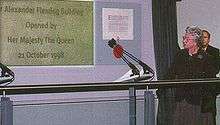
The Department of Management Science was created in 1971 and the Associated Studies Department was established in 1972. The Humanities Department was opened in 1980, formed from the Associated Studies and History of Science departments.
In 1988, Imperial merged with St Mary's Hospital Medical School, becoming The Imperial College of Science, Technology and Medicine. In 1995, Imperial launched its own academic publishing house, Imperial College Press, in partnership with World Scientific.[24] Imperial merged with the National Heart and Lung Institute in 1995 and the Charing Cross and Westminster Medical School, Royal Postgraduate Medical School (RPMS) and the Institute of Obstetrics and Gynaecology in 1997. In the same year the Imperial College School of Medicine was formally established and all of the property of Charing Cross and Westminster Medical School, the National Heart and Lung Institute and the Royal Postgraduate Medical School were transferred to Imperial as the result of the Imperial College Act 1997. In 1998, the Sir Alexander Fleming Building was opened by Queen Elizabeth II to provide a headquarters for the college's medical and biomedical research.
21st century
In 2000, Imperial merged with both the Kennedy Institute of Rheumatology and Wye College, the University of London's agricultural college in Wye, Kent. It initially agreed to keep Agricultural Sciences at Wye, but closed them in 2004.[25] Wye College was founded as the College of St Gregory and St Martin at Wye, by John Kempe, the Archbishop of York, in 1447 as a seminary, with an agricultural college being established at Wye in 1894 after the removal of the seminary.[26] In December 2005, Imperial announced a science park programme at the Wye campus, with extensive housing;[27] however, this was abandoned in September 2006 following complaints that the proposal infringed on Areas of Outstanding Natural Beauty, and that the true scale of the scheme, which could have raised £110m for the college, was known to Kent and Ashford Councils and their consultants but concealed from the public.[25] One commentator observed that Imperial's scheme reflected "the state of democracy in Kent, the transformation of a renowned scientific college into a grasping, highly aggressive, neo-corporate institution, and the defence of the status of an Area of Outstanding Natural Beauty – throughout England, not just Wye – against rampant greed backed by the connivance of two important local authorities.[28] Wye College campus was finally closed in September 2009.
In 2003 Imperial was granted degree-awarding powers in its own right by the Privy Council. The London Centre for Nanotechnology was established in the same year as a joint venture between UCL and Imperial College London.[29][30]
In 2004 the Tanaka Business School and a new Main Entrance on Exhibition Road were opened by Queen Elizabeth II. The UK Energy Research Centre was also established in 2004 and opened its headquarters at Imperial. In 2008, the Tanaka Business School was renamed the Imperial College Business School.[31]
In November 2005 the Faculties of Life Sciences and Physical Sciences merged to become the Faculty of Natural Sciences. On 9 December 2005, Imperial announced that it would commence negotiations to secede from the University of London.[32] Imperial became fully independent of the University of London in July 2007[33][34] and the first students to register for an Imperial College degree were postgraduates beginning their course in October 2007, with the first undergraduates enrolling for an Imperial degree in October 2008. In July 2008 the Centre for Advanced Structural Ceramics was opened in the Materials department.
In 2014 the Dyson School of Design Engineering was opened following a £12m donation by the James Dyson Foundation, along with courses such as the MEng in Design Engineering.[35]
Campuses

South Kensington
Imperial's main campus is located in the South Kensington area of central London.
South Kensington is home to a high concentration of cultural institutions: Natural History Museum, Science Museum, Victoria and Albert Museum, Royal College of Art, Royal College of Music, Royal Geographical Society and the Royal Albert Hall. Its location is also next to attractions: Kensington Palace and Gardens, National Art Library, Harrods Mall, and the Brompton Oratory.
The Imperial Institute was created in 1887 to celebrate Queen Victoria's Jubilee with the intention of it being a scientific research institution exploring and developing the raw materials of the Empire countries. The building was constructed in South Kensington between 1888 and 1893. The expansion of the South Kensington campus in the 1950s & 1960s absorbed the former Imperial Institute, designed by Thomas Collcutt, of which only the Queen's Tower remains among the more modern buildings.[36][37]
White City
A second major campus is currently under construction in the White City area of London. The White City Campus innovation hub will house new research facilities, space for spin-off entrepreneurial companies as well as student accommodation.[38]
Other campuses
In addition to its original South Kensington campus, Imperial has six other campuses across London and a campus in the village of Sunninghill near Ascot:
Charing Cross Campus, Hammersmith
A medical teaching and research campus based around Charing Cross Hospital. Facilities include a campus library, cafe and fitness gym.
Chelsea and Westminster Campus
A medical teaching and research campus based around Chelsea and Westminster Hospital. Facilities include a campus library.
Hammersmith Campus, East Acton
A medical teaching and research campus based around Hammersmith Hospital. Facilities include a campus library, catering outlets and sports facilities.
Royal Brompton Campus, Chelsea
A medical teaching and research campus based around the Royal Brompton Hospital. Facilities include a campus library.
St Mary's Campus, Paddington
A medical teaching and research campus based around St. Mary's Hospital. Facilities include a campus library and sports facilities.
Silwood Park
A postgraduate campus of Imperial located in the village of Sunninghill near Ascot in Berkshire. The Silwood Park campus includes a centre for research and teaching in ecology, evolution, and conservation set in 100 ha of parkland where ecological field experiments are conducted.
Administration and organization
Faculties

Imperial's research and teaching is organised within a network of faculties and academic departments.
- Imperial College Faculty of Engineering
- Imperial College Faculty of Medicine
- Imperial College Faculty of Natural Sciences
- Imperial College Business School
Global institutes
Imperial hosts cross-departmental centres that have been established to promote inter-disciplinary work.
- Energy Futures Lab
- Grantham Institute - Climate Change and Environment
- Institute for Security Science and Technology
- Institute of Global Health Innovation
- Data Science Institute
- Institute for Molecular Science and Engineering
- Francis Crick Institute
Finances and endowment
The college's endowment is sub-divided into three distinct portfolios: (i) Unitised Scheme – a unit trust vehicle for college, Faculties and Departments to invest endowments and unfettered income to produce returns for the long term; (ii) Non-Core Property – a portfolio containing around 120 operational and developmental properties which college has determined are not core to the academic mission; and (iii) Strategic Asset Investments – containing college’s shareholding in Imperial Innovations and other restricted equity holdings.[3]
Academic profile
Rankings
| ARWU[39] (2017, national) | 4 | |
|---|---|---|
| ARWU[40] (2017, world) | 22 | |
| QS[41] (2018, national) | 4 | |
| QS[42] (2018, world) | 8 | |
| THE[43] (2016/17, national) | 3 | |
| THE[44] (2016/17, world) | 8 | |
| Complete[45] (2018, national) |
5 | |
| The Guardian[46] (2018, national) |
6 | |
| Times/Sunday Times[47] (2017, national) |
5 | |
World
Imperial regularly places in the top 10 universities worldwide including in the 2016 QS World Universities Rankings and the Times Higher Education Ranking.[48] Imperial places 9th worldwide in The Ranking of Rankings (2017), which is a compilation of the results of the five most influential world university rankings: THE, QS, US News, ARWU, and Reuters World Top 100 Innovative Universities.[49]
Europe
In 2016, Imperial placed 5th best university in Europe in the Academic Ranking of World Universities, 4th in Europe in the QS World University Rankings, and 3rd in Europe in both the Times Higher Education World University Rankings and the US News & World Report Global Rankings.[50][51] Imperial is ranked 6th in the world (and 1st in Europe) in the 2016 Round University Ranking.[52]
Subject
In The World's Most Innovative Universities Rankings by Reuters, Businessweek, and the Financial Times, Imperial ranks 1st in innovation and entrepreneurship in Europe.[11][53][54][55]
In Times Higher Education World University Subject tables it is ranked 2nd in Europe, 3rd in the world for clinical and health,[56] 3rd in Europe, 7th in the world for engineering and technology,[57] 3rd in Europe, 9th in the world for life sciences[58] and 4th in Europe, 13th in the world for physical sciences.[59]

In the QS World University Subject Rankings of 2017, Imperial is ranked 12th in the world for life sciences and medicine. 6th for engineering, technology and computer sciences and 10th for natural sciences and mathematics.[60]
Imperial ranks in the U.S. News & World Report world's best universities for the following subjects: 12th for Immunology and Engineering, 13th for Clinical Medicine, 15th for Microbiology, 16th for Physics, 18th for Social Sciences and Public Health, 19th for Environment/Ecology, Materials Science, and Mathematics.[51] U.S. News & World Report ranks Imperial 1st in engineering in Europe.[61]
The Complete University Guide, (UK) ranked the following subjects in 2nd place in 2016 and 2017: Aeronautical Engineering, Chemical Engineering, Civil Engineering, Computer Science, Electrical Engineering, General Engineering and Mechanical Engineering.[62]
National
Imperial consistently scores strongly in the UK university rankings and is ranked 4th in the 2016 Times Higher Education "Table of Tables" which combines the results of the 3 main domestic league tables.[63] In the 2016 Complete University Guide, all 14 of the subjects offered by Imperial were ranked top 10 nationally meaning it was one of only two mainstream universities (along with the University of Cambridge) in the UK to have all subjects ranked in the top 10.[64]
Imperial ranked 1st in London and 3rd in the UK in the US News & World Report Global Rankings.[51]
Career
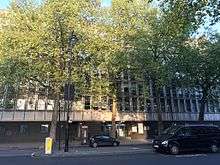
According to both the 2016 Guardian University Guide and the Complete University Guide, students were ranked as having the top employment prospects among UK universities.[65][66] As of 2014 the average starting salary of a graduate was the highest of any UK university.[67] The New York Times ranked Imperial College as one of the top 10 most-welcomed universities by the global job market.[68]
Research
The 2008 Research Assessment Exercise returned 26% of the 1225 staff submitted as being world-leading (4*) and a further 47% as being internationally excellent (3*).[69] The 2008 Research Assessment Exercise also showed five subjects – Pure Mathematics, Epidemiology an[70] d Public Health, Chemical Engineering, Civil Engineering, and Mechanical, Aeronautical and Manufacturing Engineering – were assessed to be the best in terms of the proportion of internationally recognised research quality.[71]

Imperial submitted a total of 1,257 staff across 14 units of assessment to the 2014 Research Excellence Framework (REF) assessment.[72] In the REF results 46% of Imperial's submitted research was classified as 4*, 44% as 3*, 9% as 2* and 1% as 1*, giving an overall GPA of 3.36.[73] In rankings produced by Times Higher Education based upon the REF results Imperial was ranked 2nd overall for GPA and 8th for "research power" (compared to 6th and 7th respectively in the equivalent rankings for the RAE 2008).[73]
Imperial has a dedicated technology transfer company known as Imperial Innovations. Imperial actively encourages its staff to commercialise their research and as a result has given rise to a large number of spin-out companies based on academic research.[74][75]
Imperial, in conducting research on Parkinson's disease and Multiple Sclerosis, hosts the largest brain bank in the world consisting of 296 brains donated by individuals affected with either of these diseases.[76][77]
In 2016, Imperial received £2million to establish a DNA Synthesis and Construction Foundry to accelerate developments in new synthetic biology technologies.[78]
Admissions
| 2016 | 2015 | 2014 | 2013 | 2012 | |
|---|---|---|---|---|---|
| Applications[79] | 19,200 | 18,205 | 16,570 | 15,315 | 14,740 |
| Offer Rate (%)[80] | 46.2 | 50.7 | 53.6 | 54.4 | 53.5 |
| Enrols[81] | 2,545 | 2,630 | 2,515 | 2,425 | 2,225 |
| Yield (%) | 28.7 | 28.5 | 28.3 | 29.1 | 28.2 |
| Applicant/Enrolled Ratio | 7.54 | 6.92 | 6.59 | 6.32 | 6.62 |
| Average Entry Tariff[45] | n/a | 552 | 567 | 566 | 570 |
In 2015/16, the acceptance rate was 14.3% for undergraduates and 15.9% for postgraduates.[82] At undergraduate level, there is 1 place for 7 candidates. In 2016, the domain with the lowest acceptance rate was Mechanical Engineering (11.0:1 ratio). The highest was Bioengineering (3.8:1) but it was also the course with the highest UCAS Tariff entry (600).[82] By way of example, acceptance ratio in Mathematics was of 8.0:1 and in Medicine was of 7.3:1.[82]
Medicine
The Imperial Faculty of Medicine was formed through mergers between Imperial and the St Mary's, Charing Cross and Westminster, and Royal Postgraduate medical schools and has six teaching hospitals. It accepts more than 300 undergraduate medical students per year and has around 321 taught and 700 research full-time equivalent postgraduate students.
Imperial College Healthcare NHS Trust was formed on 1 October 2007 by the merger of Hammersmith Hospitals NHS Trust (Charing Cross Hospital, Hammersmith Hospital and Queen Charlotte's and Chelsea Hospital) and St Mary's NHS Trust (St. Mary's Hospital and Western Eye Hospital) with Imperial College London Faculty of Medicine.[83] It is an academic health science centre and manages five hospitals: Charing Cross Hospital, Queen Charlotte's and Chelsea Hospital, Hammersmith Hospital, St Mary's Hospital, and Western Eye Hospital. The Trust is currently one of the largest in the UK and in 2012/13 had a turnover of £971.3 million, employed approximately 9,770 people and treated almost 1.2 million patients.[84]
Other (non-academic health science centres) hospitals affiliated with Imperial College include Chelsea and Westminster Hospital, Royal Brompton Hospital, West Middlesex University Hospital, Hillingdon Hospital, Mount Vernon Hospital, Harefield Hospital, Ealing Hospital, Central Middlesex Hospital, Northwick Park Hospital, St. Mark's Hospital, St Charles' Hospital and St Peter's Hospital.[85]
Controversies
Wye campus sale

Imperial acquired Wye College in 2000, which is set in a designated Area of Outstanding Natural Beauty. It was rapidly dismantled, causing controversy, particularly a plan for substantial redevelopment in the area, with adverse environmental implications. A local campaign eventually secured the overthrow of the scheme, following which the Wye campus was closed in September 2009.[28] The Wye campus, some of it dating back to the 15th century, is currently vacant and available for sale or rent.
Accusations of bullying
In 2003, it was reported that one third of female academics "believe that discrimination or bullying by managers has held back their careers".[86] It was said then that "A spokesman for Imperial said the college was acting on the recommendations and had already made changes". Nevertheless, allegations of bullying have continued. In 2007, concerns were raised about the methods that were being used to fire people in the Faculty of Medicine.[87][88] In 2014, Stefan Grimm, of the Department of Medicine, was found dead after being threatened with dismissal for failure to raise enough grant money.[89] Grimm's last email accused his employers of bullying by demanding that he should get grants worth at least £200,000 per year.[90][91] The College announced an internal inquiry into Stefan Grimm's death, and found that the performance metrics for his position were unreasonable, with new metrics for performance being needed.[92]
Student life
Imperial College London's strive for their students success goes far beyond academics; a complete refurbishment of two floors of the library was put into action to modernise the learning space and enhance the student experience. Open 24 hours a day and for 7 days of the week, Imperial College turned their library into a place students can go to get motivated and get the most out of their study time.[93]
Student body
For the 2015/16 academic year, Imperial had a total full-time student body of 17,035, consisting of 9,240 undergraduate students and 7,795 postgraduates.[5] 50.7% of the student body is from outside of the UK.[94] 32% of all full-time students came from outside the European Union in 2013-14,[95] and around 13% of the International students had Chinese nationality in 2007-08.[96]
Imperial's male–female ratio for undergraduate students is uneven at approximately 64:36 overall[96] and 5:1 or higher in some engineering courses. However, medicine has an approximate 1:1 ratio with biology degrees tending to be higher.[97]
Imperial College Union
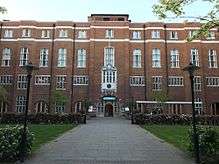
Imperial College Union is the students' union and is run by five full-time sabbatical officers elected from the student body for a tenure of one year, and a number of permanent members of staff. The Union is given a large subvention by the university, much of which is spent on maintaining around 300 clubs, projects and societies.[98] Examples of notable student groups and projects are Project Nepal which sends Imperial College students to work on educational development programmes in rural Nepal[99] and the El Salvador Project, a construction based project in Central America.[100] The Union also hosts sports-related clubs such as Imperial College Boat Club and Imperial College Gliding Club.
The Union operates on two sites; Beit Hall, South Kensington and Reynold's, Hammersmith.

Facilities
Sports facilities at Imperial's London campuses include four gyms, two swimming pools and two sports halls.[101] Imperial has additional sports facilities at the Heston and Harlington sports grounds.
On the South Kensington campus, there are a total of six music practice rooms which consist of upright pianos for usage by people of any grade, and grand pianos which are exclusively for people who have achieved Grade 8 or above.[102]
There are two student bars on the South Kensington campus, one at the Imperial College Union and one at Eastside.[103]
Student activities
Imperial College Radio
Imperial College Radio (or ICRadio) was founded in November 1975 with the intention of broadcasting to the student halls of residence from a studio under Southside, actually commencing broadcasts in late 1976. It now broadcasts from the West Basement of Beit Quad over the internet.[104]
Imperial College TV
Imperial College TV (ICTV) is Imperial College Union's TV station, founded in 1969 and operated from a small TV studio in the Electrical Engineering block. The department had bought an early AMPEX Type A 1-inch videotape recorder and this was used to produce an occasional short news programme which was then played to students by simply moving the VTR and a monitor into a common room. A cable link to the Southside halls of residence was laid in a tunnel under Exhibition Road in 1972. Besides the news, early productions included a film of the Queen opening what was then called College Block.
Felix Newspaper
Felix is weekly student newspaper, first released on 9 December 1949.[105] In addition to news, Felix also carries comic strips, features, opinions, puzzles and reviews, plus reports of trips and Imperial College sporting events.
Imperial College Boat Club
The Imperial College Boat Club is the rowing club of Imperial and was founded on 12 December 1919. The club has a number of notable accolades, such as three alumni of the college in the gold medal winning GB 8+ at the 2000 Sydney Olympics, along with their coach Martin McElroy. The club has been highly successful, with many wins at Henley Royal Regatta.
Exploration Club
Imperial's Exploration Board was established in 1957 to assist students with a desire for exploration. Trips have included Afghanistan, Alaska, Cameroon, Ethiopia, Fiji, the Himalayas, Iran, Morocco, Norway, Tanzania, Thailand, Ukraine, and the Yukon.[106]
Dramatic Society
The Imperial College Dramatic Society (ICDS or DramSoc) is one of two major theatrical arts societies, with the other being the Musical Theatre Society, and it was founded in 1912.[107] The society puts on three major plays each year, in addition to several smaller fringe productions. It is additionally one the London-based dramatic societies to participate in the London Student Drama Festival,[108] and regularly attends the Edinburgh Fringe. ICDS is responsible for the day-to-day maintenance of the Union's theatrical space, the Union Concert Hall.
Bars and Pubs
There are a number of popular pubs and bars on campus and also surrounding the campus, which become a popular social activity for Imperial's students. The Pewter tankard collection at Imperial College Union is the largest in Europe, with the majority of clubs and societies having tankards associated with their clubs.[109]
Student housing
Imperial College owns and manages twenty one halls of residence in Inner London, Ealing, Ascot and Wye. Over three thousand rooms are available, guaranteeing first year undergraduates a place in College residences.
The majority of halls offer single or twin accommodation with some rooms having en suite facilities. Study bedrooms are provided with basic furniture and with access to shared kitchens and bathrooms. The majority of rooms come with internet access and access to the Imperial network. Most of them are considered among the newest student halls at London universities.
Most students in college or university accommodation are first-year undergraduates, since they are granted a room once they have selected Imperial as their firm offer at UCAS. The majority of older students and postgraduates find accommodation in the private sector, help for which is provided by the college private housing office. However a handful of students may continue to live in halls in later years if they take the position of a "hall senior". Some students also live in International Students House, London.

List of Halls of Residence:
- South Kensington Village
- Beit Hall
- Garden Hall
- Weeks Hall
- Eastside
- Linstead Hall
- Gabor Hall
- Wilkinson Hall
- Southside
- Falmouth Hall
- Selkirk Hall
- Tizard Hall
- Keogh Hall
- Evelyn Gardens
- Bernard Sunley Hall
- Fisher Hall
- Holbein Hall
- Southwell Hall
- Willis Jackson Hall
- Wilson House
- Boathouse
- Orient House
- Parsons House
- Pembridge Hall
- Woodward
- Xenia
Notable alumni, faculty and staff
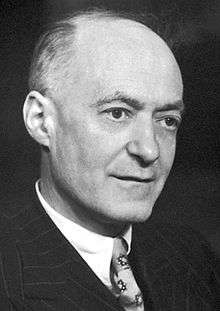
 Sir Abdus Salam
Sir Abdus Salam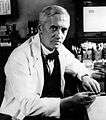
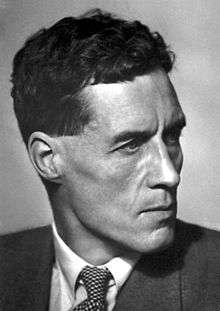
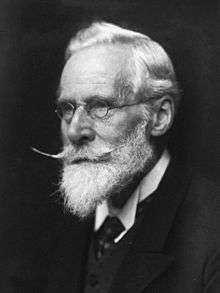 Sir William Crookes
Sir William Crookes

 Sir John Pendry
Sir John Pendry
.jpg)
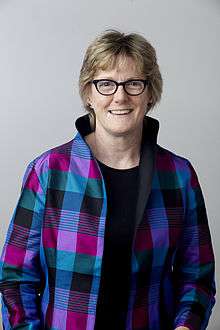 Dame Sally Davies
Dame Sally Davies
Nobel laureates: (medicine) Sir Alexander Fleming, Sir Ernst Boris Chain, Sir Frederick Gowland Hopkins, Sir Andrew Fielding Huxley, Rodney Robert Porter, (physics) Abdus Salam, Sir George Paget Thomson, Patrick Blackett, Baron Blackett, Dennis Gabor, Peter Higgs, (chemistry) Sir Norman Haworth, Sir Cyril Norman Hinshelwood, Sir Derek Barton, Sir Geoffrey Wilkinson, Sir George Porter.[12]
Academic affiliations include: Sir Tom Kibble, co-discoverer of Higgs Boson;[110] Sir Tejinder Virdee, experimental particle physicist;[111] Sir John Pendry, theoretical solid state physicist;[112] Sir Christopher Kelk Ingold, physical organic chemistry pioneer;[113] Sir William Henry Perkin, discoverer of the first synthetic organic chemical dye mauveine;[114] Sir Edward Frankland, originator of the theory of chemical valency;[115] Sir William Crookes, discoverer of thallium;[116] Sir Alan Fersht, chemist; David Phillips, chemist; Murad Osmann, Harold Hopkins, contributed to the theory and design of optical instruments;[117] Alfred North Whitehead, mathematician and philosopher;[118] Steven Cowley, physicist and president of Corpus Christi College, Oxford;[119] and Sir John Ambrose Fleming, inventor of the vacuum tube.[120]
In biology and medicine; Thomas Huxley, advocate of the theory of evolution; Wendy Barclay, virologist; Dame Sally Davies, the Chief Medical Officer for England; David Livingstone, medical missionary. In engineering; Dame Julia Higgins, polymer scientist; Dame Judith Hackitt, former Chair of the Health and Safety Executive; Dudley Maurice Newitt, scientific director of the Special Operations Executive; Julia King, Baroness Brown of Cambridge, engineer and Member of the House of Lords.
Non-academic affiliations include: H. G. Wells, author; Nicholas Tombazis, chief car designer at McLaren and Ferarri; Ralph Robins, CEO of Rolls-Royce;[121] Brian May, guitarist of rock band Queen;[122] Chew Choon Seng, CEO of Singapore Airlines; Sir Julius Vogel, former Prime Minister of New Zealand;[123] Rajiv Gandhi, Prime Minister of India;[124] Teo Chee Hean, Deputy Prime Minister of Singapore; Huw Thomas, Physician to the Queen;[125] Sir Roger Bannister, ran the first four-minute mile;[126] Andreas Mogensen, first Danish astronaut; Winston Wong, entrepreneur; Alan Howard, hedge fund manager and philanthropist; Cyrus Pallonji Mistry, former chairman of the Tata Group;[127] Michael Birch, entrepreneur; Henry Charles Stephens, politician; Sir Michael Uren, businessman and philanthropist; Ian Read, CEO of Pfizer.
References
- ↑ The coat of arms was given to Imperial College by Royal Warrant of King Edward VII.
- ↑ PJGILL. "Charitable status". Retrieved 30 September 2014.
- 1 2 3 "Annual Report and Accounts 2015-16" (PDF). Imperial College London. Retrieved 21 December 2016.
- 1 2 "Annual Report and Accounts 2013–14" (PDF). Imperial College London. p. 8. Retrieved 2 January 2014.
- 1 2 3 4 "2015/16 Students by HE provider, level, mode and domicile" (XLSX). Higher Education Statistics Agency. Retrieved 17 February 2017.
- ↑ "History of Imperial College" (PDF).
- ↑ "Ted Talks Imperial College London HIstory".
- 1 2 "A timeline of College Developments". Imperial College London.
- ↑ "Imperial College splits from University of London". The Guardian. 5 October 2006. Retrieved 27 November 2015.
- ↑ "Imperial College London: League tables". Imperial College London.
- 1 2 "Reuters". The World's Most Innovative Universities.
- 1 2 "Award winners | Imperial College London". Imperial.ac.uk. Retrieved 10 March 2015.
- 1 2 "History of Imperial College" (PDF).
- ↑ "Ted Talks Imperial College London HIstory".
- 1 2 3 4 5 "Imperial College – Centenary website – Timeline – 1845–1899". Imperial.ac.uk. Retrieved 23 March 2011.
- ↑ "Arbertopolis - The Wisdom of Prince Albert".
- ↑ "Ted Talks History of Imperial College".
- ↑ "History of Imperial College 3".
- ↑ "History of ICSTM Chemistry". Retrieved 30 September 2014.
- ↑ "SCI - America Group Awards". Soci.org. Retrieved 10 March 2015.
- ↑ "City & Guild". www.asiapacific.org.pk. 2016. Retrieved 7 October 2016.
- ↑ http://www.wolfson.org.uk/media/2411/wf_sixty-years-of-philanthropy.pdf
- ↑ "Imperial College - Centenary website - Timeline - 1960-1969". www.imperial.ac.uk. Retrieved 19 December 2016.
- ↑ "Imperial College Press". Icpress.co.uk. Retrieved 23 March 2011.
- 1 2 David Hewson. 2007. 'Saved; How an English village fought for its survival and won'. Leicester: Troublador Publishing
- ↑ "The Cardinals of the Holy Roman Church – Biographical Dictionary – Consistory of December 18, 1439". Retrieved 30 September 2014.
- ↑ "Imperial College London – New £1 billion world-class scientific research centre and facilities planned for Kent". Imperial.ac.uk. Retrieved 16 June 2011.
- 1 2 David Hewson. 2007. Saved; How an English village fought for its survival and won. Leicester: Troublador Publishing.
- ↑ Frood, Arran (27 January 2003). "London's little idea". BBC News. Retrieved 20 July 2012.
- ↑ "Nanotech under the microscope". BBC News. 12 June 2003. Retrieved 20 July 2012.
- ↑ "New identity for Imperial College Business School". Imperial College London. Retrieved 20 June 2017.
- ↑ "Imperial College London – Imperial College London to begin negotiations to withdraw from the University of London". Imperial.ac.uk. 9 December 2005. Retrieved 16 June 2011.
- ↑ "Imperial College top choice for Singaporean students". Comp.nus.edu.sg. Retrieved 23 March 2011.
- ↑ "University of London: Updated position statement re: Imperial College London". London.ac.uk. Retrieved 16 June 2011.
- ↑ Smithers, Rebecca (23 March 2015). "James Dyson Foundation gives £12m for creation of engineering school". The Guardian. London. Retrieved 31 March 2015.
- ↑ "Imperial Institute | British History Online". British-history.ac.uk. Retrieved 10 March 2015.
- ↑ "Imperial College | British History Online". British-history.ac.uk. Retrieved 10 March 2015.
- ↑ Barrett, Claer (5 August 2014). "Imperial unveils details of £3bn campus extension" – via Financial Times.
- ↑ "Academic Ranking of World Universities 2017 - UK". Shanghai Ranking Consultancy. Retrieved 15 August 2017.
- ↑ "Academic Ranking of World Universities 2017". Shanghai Ranking Consultancy. Retrieved 15 August 2017.
- ↑ "QS World University Rankings 2018 - United Kingdom". Quacquarelli Symonds Ltd. Retrieved 8 June 2017.
- ↑ "QS World University Rankings 2018". Quacquarelli Symonds Ltd. Retrieved 8 June 2017.
- ↑ "World University Rankings 2016-17 - United Kingdom". Times Higher Education. Retrieved 21 September 2016.
- ↑ "World University Rankings 2016-17". Times Higher Education. Retrieved 21 September 2016.
- 1 2 "University League Table 2018". The Complete University Guide. Retrieved 26 April 2017.
- ↑ "University league tables 2018". The Guardian. 16 May 2017. Retrieved 16 May 2017.
- ↑ "The Times and Sunday Times University Good University Guide 2017". Times Newspapers. Retrieved 23 September 2016.
- ↑ "Times Higher Education". World University Rankings 2016.
- ↑ ""Ranking of Rankings"". Uni Ranks.
- ↑ "Best universities in Europe". Times Higher Education.
- 1 2 3 "Top Universities in Europe | US News Best Global Universities". Usnews.com. 28 October 2014. Retrieved 10 March 2015.
- ↑ "Round University Rankings 2016". RUR Rankings Agency. Retrieved 22 September 2016.
- ↑ "Financial Times" (PDF). MBA's in Entrepreneurship.
- ↑ "MBA Rankings: Top Schools for Entrepreneurship - Businessweek". Bloomberg.com.
- ↑ "Imperial Ranked #1 for Entrepreneurship - Executive MBA" (PDF). Financial Times.
- ↑ "2010 – Top 50 Clinical, Pre-Clinical and Health universities". Times Higher Education. Retrieved 19 October 2010.
- ↑ "World University Rankings 2016-2017 by subject: engineering and technology". Times Higher Education. Retrieved 13 July 2017.
- ↑ "2010 – Top 50 Life Sciences universities". Times Higher Education. Retrieved 19 October 2010.
- ↑ "2010 – Top 50 Physical Sciences universities". Times Higher Education. Retrieved 19 October 2010.
- ↑ "QS World University Rankings by Subject 2017". Top Universities. Retrieved 23 April 2017.
- ↑ "Best Global Universities for Engineering". U.S. News & World Report. 2015. Retrieved 12 December 2015.
- ↑ "Rankings". Imperial College London. Retrieved 23 April 2017.
- ↑ Chris Havergal (15 October 2015). "THE ‘Table of Tables’ 2016: University of Cambridge top for fifth year running". Times Higher Education.
- ↑ "Who's Who in the Subject League Tables". thecompleteuniversityguide.co.uk.
- ↑ "Guardian University Guide". The Guardian.
- ↑ "Career University Guide". Career Prospects.
- ↑ "Login". Retrieved 30 September 2014.
- ↑ "What the job market wants". The New York Times. 25 October 2012. Retrieved 7 February 2013.
- ↑ "THE Table of Excellence". Times Higher Education. 18 December 2008. Retrieved 16 August 2013.
- ↑ Archived 25 December 2008 at the Wayback Machine.
- ↑ "Profile Imperial College London". The Times. London. 1 June 2009. Retrieved 2 April 2010.
- ↑ "REF 2014 winners: who performed best?". Times Higher Education. 18 December 2014. Retrieved 5 April 2015.
- 1 2 "Overall ranking of institutions including power market share". Times Higher Education. 18 December 2014. Retrieved 5 April 2015.
- ↑ "Background to the Group – Imperial Innovations".
- ↑ "How Imperial College is turning innovation into cash". 30 November 2015.
- ↑ "UK Parkinson's Disease Society Tissue Bank". Parkinsonstissuebank.org.uk. 26 April 2009. Retrieved 23 March 2011.
- ↑ Green, Chris (20 April 2009). "Paxman to donate brain to charity". The Independent. London. Retrieved 2 April 2010.
- ↑ Bawden, Tom. "'DNA factory' opens at Imperial College London". Independent. Retrieved 13 April 2016.
- ↑ "End of Cycle 2016 Data Resources DR4_001_03 Applications by provider". UCAS. UCAS. 2016. Retrieved 10 February 2017.
- ↑ "Sex, area background and ethnic group: I50 Imperial College London". UCAS. UCAS. 2016. Retrieved 10 February 2017.
- ↑ "End of Cycle 2016 Data Resources DR4_001_02 Main scheme acceptances by provider". UCAS. UCAS. 2016. Retrieved 10 February 2017.
- 1 2 3 "Admission Statistics" (PDF). Imperial College London Statistics. Imperial College London. Retrieved 18 December 2016.
- ↑ "About us – Imperial College Healthcare NHS Trust Internet". Imperial.nhs.uk. Retrieved 23 March 2011.
- ↑ "Annual Report 2012/13" (PDF). Imperial College Healthcare NHS Trust. Retrieved 28 April 2013.
- ↑ "Meet the Council". Chelsea and Westminster NHS Foundation Trust. Archived from the original on 14 September 2009. Retrieved 14 September 2009.
- ↑ "Female staff 'feel bullied' at Imperial College". Retrieved 6 December 2014.
- ↑ "Crude recipe for a 'chicken-run' sector". Retrieved 6 December 2014.
- ↑ Colquhoun, David (2007). "How to get good science." (PDF). Physiology News. 69: 12–14.
- ↑ "Imperial College London to 'review procedures' after death of academic". Retrieved 6 December 2014.
- ↑ "Publish and perish at Imperial College London: the death of Stefan Grimm". Retrieved 6 December 2014.
- ↑ "Imperial College professor Stefan Grimm 'was given grant income target'". Retrieved 6 December 2014.
- ↑ "Stefan Grimm inquest: new policies may not have prevented suicide". Times Higher Education (THE). 9 April 2015. Retrieved 23 January 2017.
- ↑ "Imperial College London Refurbishment". Willmott Dixon Interiors.
- ↑ "World-ranked universities with the most international students". Times Higher Education. Retrieved 30 September 2015.
- ↑ "2013/14 Students by HE provider, level, mode and domicile" (XLSX). Higher Education Statistics Agency. Retrieved 8 November 2015.
- 1 2 "Statistics Pocket Guide 2009–10" (PDF). Imperial College London. Retrieved 16 August 2013.
- ↑ "Search best UK universities, make university comparisons and see student satisfaction ratings and UCAS points". Unistats. Retrieved 23 March 2011.
- ↑ Dave Parry. "Imperial College Union". Union.ic.ac.uk. Retrieved 16 June 2011.
- ↑ "Felix : The student voice of Imperial College London" (PDF). Felixonline.co.uk. Retrieved 10 March 2015.
- ↑ "Sponsors". Elsalvadorproject.org.uk. Retrieved 10 March 2015.
- ↑ Imperial College London. "Imperial College Sports Facilities". imperial.ac.uk. Retrieved 21 March 2012.
- ↑ Imperial College London. "Imperial College Music Facilities". imperial.ac.uk. Retrieved 21 March 2012.
- ↑ Imperial College Union. "Food and Drink". imperialcollegeunion.org. Retrieved 21 March 2012.
- ↑ "Imperial College Radio, London, UK". Icradio.com. Retrieved 16 June 2011.
- ↑ "Imperial College - Centenary website - Timeline - 1940-1949". www.ic.ac.uk.
- ↑ "Exploration Club". A timeline of College Developments.
- ↑ "Dramatic Changes" (371). Felix Newspaper. 9 December 1974. Retrieved 28 June 2015.
- ↑ "London Student Drama Festival". UCLU Drama. UCLU Drama Society. Retrieved 28 June 2015.
- ↑ "Questions about Tankards".
- ↑ ‘KIBBLE, Sir Thomas (Walter Bannerman)’, Who Was Who, A & C Black, an imprint of Bloomsbury Publishing plc, 1920–2016; online edn, Oxford University Press, 2016 ; online edn, Nov 2016 accessed 2 April 2017
- ↑ ‘VIRDEE, Sir Tejinder Singh’, Who's Who 2017, A & C Black, an imprint of Bloomsbury Publishing plc, 2017; online edn, Oxford University Press, 2016 ; online edn, Nov 2016 accessed 2 April 2017
- ↑ ‘PENDRY, Sir John (Brian)’, Who's Who 2017, A & C Black, an imprint of Bloomsbury Publishing plc, 2017; online edn, Oxford University Press, 2016 ; online edn, Nov 2016 accessed 2 April 2017
- ↑ ‘INGOLD, Sir Christopher (Keik)’, Who Was Who, A & C Black, an imprint of Bloomsbury Publishing plc, 1920–2016; online edn, Oxford University Press, 2014 ; online edn, April 2014 accessed 2 April 2017
- ↑ ‘PERKIN, Sir William Henry’, Who Was Who, A & C Black, an imprint of Bloomsbury Publishing plc, 1920–2016; online edn, Oxford University Press, 2015 ; online edn, Feb 2015 accessed 2 April 2017
- ↑ ‘FRANKLAND, Sir Edward’, Who Was Who, A & C Black, an imprint of Bloomsbury Publishing plc, 1920–2016; online edn, Oxford University Press, 2014 ; online edn, April 2014 accessed 2 April 2017
- ↑ ‘CROOKES, Prof. Sir William’, Who Was Who, A & C Black, an imprint of Bloomsbury Publishing plc, 1920–2016; online edn, Oxford University Press, 2014 ; online edn, April 2014 accessed 2 April 2017
- ↑ ‘HOPKINS, Prof. Harold Horace’, Who Was Who, A & C Black, an imprint of Bloomsbury Publishing plc, 1920–2016; online edn, Oxford University Press, 2014 ; online edn, April 2014 accessed 2 April 2017
- ↑ ‘WHITEHEAD, Alfred North’, Who Was Who, A & C Black, an imprint of Bloomsbury Publishing plc, 1920–2016; online edn, Oxford University Press, 2014 ; online edn, April 2014 accessed 2 April 2017
- ↑ ‘COWLEY, Prof. Steven’, Who's Who 2017, A & C Black, an imprint of Bloomsbury Publishing plc, 2017; online edn, Oxford University Press, 2016 ; online edn, Nov 2016 accessed 2 April 2017
- ↑ ‘FLEMING, Sir (John) Ambrose’, Who Was Who, A & C Black, an imprint of Bloomsbury Publishing plc, 1920–2016; online edn, Oxford University Press, 2014 ; online edn, April 2014 accessed 2 April 2017
- ↑ ‘ROBINS, Sir Ralph (Harry)’, Who's Who 2017, A & C Black, an imprint of Bloomsbury Publishing plc, 2017; online edn, Oxford University Press, 2016 ; online edn, Nov 2016 accessed 2 April 2017
- ↑ ‘MAY, Dr Brian Harold’, Who's Who 2017, A & C Black, an imprint of Bloomsbury Publishing plc, 2017; online edn, Oxford University Press, 2016 ; online edn, Nov 2016 accessed 2 April 2017
- ↑ ‘VOGEL, Hon. Sir Julius’, Who Was Who, A & C Black, an imprint of Bloomsbury Publishing plc, 1920–2016; online edn, Oxford University Press, 2014 ; online edn, April 2014 accessed 2 April 2017
- ↑ ‘GANDHI, Rajiv’, Who Was Who, A & C Black, an imprint of Bloomsbury Publishing plc, 1920–2016; online edn, Oxford University Press, 2014 ; online edn, April 2014 accessed 2 April 2017
- ↑ ‘THOMAS, Prof. Huw Jeremy Wyndham’, Who's Who 2017, A & C Black, an imprint of Bloomsbury Publishing plc, 2017; online edn, Oxford University Press, 2016 ; online edn, Nov 2016 accessed 2 April 2017
- ↑ ‘BANNISTER, Sir Roger (Gilbert)’, Who's Who 2017, A & C Black, an imprint of Bloomsbury Publishing plc, 2017; online edn, Oxford University Press, 2016 ; online edn, Nov 2016 accessed 2 April 2017
- ↑ ‘MISTRY, Cyrus Pallonji’, Who's Who 2017, A & C Black, an imprint of Bloomsbury Publishing plc, 2017; online edn, Oxford University Press, 2016 ; online edn, Nov 2016 accessed 2 April 2017
External links
| Wikimedia Commons has media related to Imperial College London. |
Coordinates: 51°29′54″N 0°10′37″W / 51.498356°N 0.176894°W


